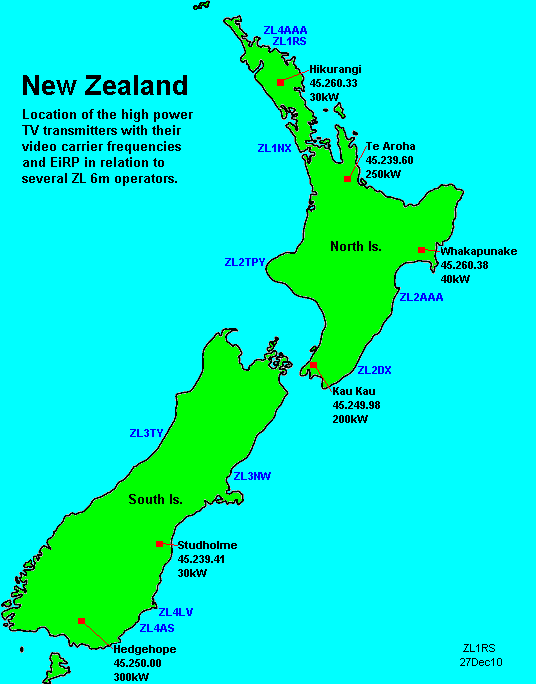New Zealand's TV system is similar to Australia's in that it uses 625-lines and 25 frames per second, with the FM sound carrier 5.5 MHz higher than the video. The principal difference is that the ZL channels are set 1-MHz lower, so that their lowest, Ch 1, has its video at 45.25 MHz (+/- various offsets).
Though some instances of US west coast reception were noted in Cycle 20 (1970) it wasn't until the resurgence of the more-intense Cycle 21 that widespread notice was taken by the 50-MHz community much outside of the ZL area. In the late 70's the lower 1-MHz of the band there was off limits for amateur use. In fact some operators were so close to some TV transmitters that they had to flee another 1 MHz higher to avoid QRM from them! Even with these limitations I was able to QSO all four call areas up at 51-52 in April 1979.
Over the next few years with the help of NZART permission was granted to those not within a Ch 1 service area to operate 50-51, and those that were could still do so if the transmitter were off or just broadcasting non-programming (i.e., test pattern). This led to some highly-variable "windows" for the various operators across the country, more so when some special-event telecasts might extend the broadcast day. The TV t/on's were normally rather late (after 2000Z), and many came to rely on the US reports of those signals via 28.885 MHz before they'd pay much close attention. This often resulted in some of the earlier time-frame openings being totally overlooked!
The access to the lowest end of the band undoubtedly made contacts to the US east coast a much easier event for many than it would otherwise have been. In the April period those paths were also often extended via Es links.
Though I did try to use the same TV system for ZL as I'd been using with the BBC, the complication of having to adjust the horizontal oscillator back up to near 15.6-kHz in the afternoons was only slightly compensated for by the fact that the video modulation polarity matched (unlike with the UK) so any picture would likely be more decipherable. About all that I ever got were some frame bars. One always had to be alert for any possible leakage from another nearby US set's i.f. strip!
By Cycle 22 a loaner 3" battery portable set made for the VK market was tried - but by then the local 43-MHz paging systems and the 46-MHz bases for the cordless phones were obliterating any wide-bandpass receiver such as that was. Some tuneable traps might have helped, but I lacked things like a sweep generator system to construct/tweak them properly.
For those with semi-wide band FM detectors in their 6-m rigs (certainly not my Swan 250 or IC-551D) the 50.75 MHz could provide considerable audio. I'd tried it into the SX-62, (like I had the VK Ch 0) and later some various Bearcat scanners (which were mostly too narrow for the deviation being used). This is some of the best that I was able to render It's from the Commonwealth Games where the figure "386.04" come thru very well. (Among my scores of C-90 cassette tapes there might be some better yet to be found.)
After taking so great a lead in obtaining extra room on 50-MHz, the outlook in ZL has again turned to the bleaker side with actually some new Ch 1 transmitters being put on in areas that had been "free" of them in the past! ZL3TY had an excellent synopsis of the latest situation/prognosis there.
